|
DekTec Modulators A complete line of PCIe and USB modulators that cover virtually all digital-TV standards used in the world. The modulators use an all-digital design coupled with SDR techniques that provide the best signal quality and a high degree of flexibility to add new modulation schemes.
|
Modulators for USB Bus and PCI Express
| DTU-215 | DTU-315 | DTA-2111B | DTA-2115B | DTA-2116 | |
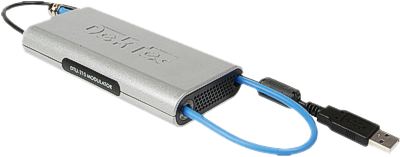 |
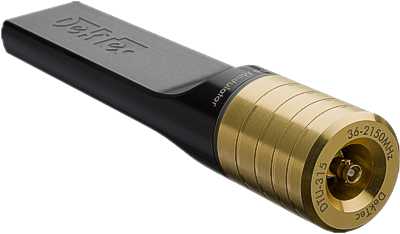 |
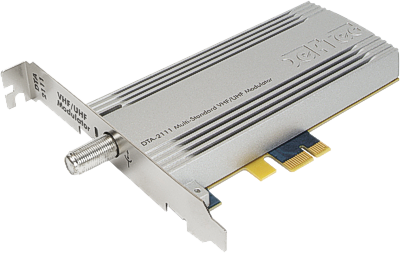 |
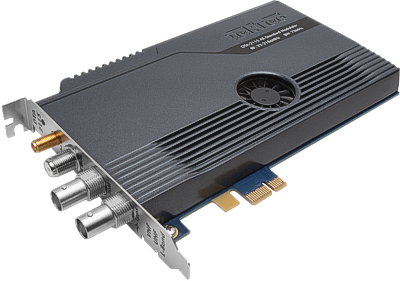 |
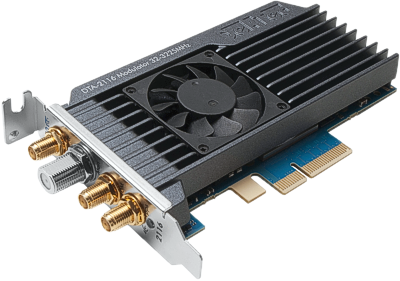 |
|
|
List priceThe suggested retail price for the product. Quantity discounts and OEM arrangements may apply. Please direct OEM queries directly to one of the DekTec offices.
|
End Of Life | € 2.782 | € 910 | € 3.947 | € 2.796 |
| Form factor | USB-2 device | USB-3 device | PCIe card | PCIe card | PCIe card |
| Cable | |||||
| Satellite | |||||
| Terrestrial | |||||
| 10-MHz/1-pps sync | |||||
| RF band | VHF, UHF | VHF, UHF, L band | VHF, UHF | VHF, UHF, L band | VHF, UHF, L band |
|
RF range
Carrier frequency range supported at the output of the modulator.
|
36 .. 1002MHz | 36 .. 2150MHz | 36 .. 1002MHz | 32 .. 2186MHz | 32 .. 3225MHz |
|
Output level
Range of output power that the modulator can produce. Note that the limits can
vary depending on the type of modulation.
|
-49 .. -15dBm | -55 .. -25dBm | -35 .. -9dBm | -60 .. 0dBm | -90 .. -5dBm |
| #RF ports | 1 | 1 | 1 | main, monitor | main, monitor |
| RF connector | 75-Ω F male | 75-Ω micro BNC | 75-Ω F female | 50-Ω SMA, 75-Ω F | 50-Ω SMA, 75-Ω F |
|
Low-profile PCIeLow profile PCIe cards are 'half height', for mounting in a low-profile PC case. DekTec cards come standard with a full-height bracket and a separate low-profile bracket in the box.
Add -LP to the model number to order a card with a low-profile bracket already mounted. |
|||||
| PCI Express | Gen1 x1 | Gen3 x1 | Gen3 x4 |
Standards included with the base product |
|||||
| DTU-215 | DTU-315 | DTA-2111B | DTA-2115B | DTA-2116 | |
|
ATSC 1.0Standard: ATSC A/53E
"ATSC 1.0", launched in 1996, is the designation used (retroactively) to describe the first digital terrestrial standard developed by the Advanced Television Systems Committee (ATSC).ATSC 1.0 uses 8-level vestigial sideband modulation (8VSB) in a 6MHz channel. The symbol rate is fixed to 10.76MBd, giving a net bitrate of 19.39Mbit/s. ATSC 1.0 is used primarily in North America and in Korea. |
|||||
|
DVB-CIDStandard: ETSI TS 103 129 v1.1.2
DVB-CID (Carrier ID) is a signal embedded in a satellite signal. It allows satellite operators and end users to identify the source of a satellite carrier, even when it can no longer be demodulated due to interference. CID is modulated using spread spectrum techniques. This means the signal can be injected at noise level, so that the impact of the CID signal on the MER of the satellite signal is negligible. |
|||||
|
DVB-HStandard: ETSI EN 302 304
DVB-H is a superset of DVB-T for mobile TV broadcasting. DVB-H failed in the market due to lack of receivers and the advent of 4G. |
|||||
|
DVB-SStandard: ETSI EN 300 421
DVB-S for digital satellite broadcasting was the first digital-TV modulation standard released by DVB (1995). It has been used extensively for contribution feeds and for direct to home (DTH) broadcasting. DVB-S is a relatively straightforward system using QPSK, Reed-Solomon forward error correction and bit interleaving. DVB-S has been used all over the world but is now replaced by DVB-S2 which is more efficient. |
|||||
|
DVB-S2Standard: ETSI EN 302 307
DVB-S2 is a second generation standard for satellite television. It uses higher level modulation modes up to 256APSK and powerful LDPC error correction for better spectrum efficiency than DVB-S. It is used all over the world. |
|||||
|
DVB-T2 single PLP>Standard: ETSI EN 302 755
DVB-T2 with a single PLP (which is the most common case in practice). For multi-PLP the full "DVB-T2" option is required. |
|||||
|
J.83BStandard: ITU-T J.83 Annex B, also known as "J.83B" or "QAM-B"
First-generation cable-modulation standard based on QAM modulation with 7-bit symbols (customary is 8 bits), Reed-Solomon forward error correction, symbol interleaving, and 64- or 256-QAM. J.83B is mainly used in North America and Korea. |
|||||
|
QAM-CStandard: ITU-T J.83 Annex C
First-generation cable-modulation standard based on QAM modulation. Very similar to QAM-A (=DVB-C), only the roll-off factor is different (QAM-A:0.15, QAM-C:0.13). QAM-C is used in parts of Asia. |
|||||
Chargeable modulation options |
|||||
| DTU-215 | DTU-315 | DTA-2111B | DTA-2115B | DTA-2116 | |
|
ATSC 3.0Standard: ATSC A/300, Korea TTAK.KO-07.0127
Where conventional standards use MPEG-2 transport streams, ATSC 3.0 is fully IP based. This enables hybrid broadcast and broadband service delivery e.g. for personalized advertisements. OFDM modulation with LDPC error correction are used to deliver multiple physical layer pipes (PLPs) with IP content over terrestrial networks. ATSC 3.0 modulation is used primarily in North America and in Korea. Note: Korea uses a different version of the standard that is incompatible with the standard used in North America. |
|||||
|
ATSC M/HStandard: ATSC A/153
ATSC-M/H is a mobile TV extension of ATSC 1.0. It is not widely used at this point in time. |
|||||
|
CMMBStandard: GY/T 220.1/2-2006
CMMB (China Mobile Multimedia Broadcasting) is a mobile television and multimedia standard developed in China. It is intended to be used with small screens. |
|||||
|
For modulating DAB in the 1452-1492MHz band.
The DTA-2107 does not support modulation in Band III (174 to 240MHz), which is the frequency range primarily used for transmitting DAB. |
|||||
|
DRM(+)Standard: ETSI ES 201 980
DRM (Digital Radio Mondiale) is a modulation standard designed for digital radio in the AM band. It is based on an open standard. For frequencies above 30Mhz it is referred to as DRM+. |
|||||
|
DTMBStandard: GB 20600-2006
DTMB (Digital Terrestrial Multimedia Broadcast) is the digital TV standard for mobile and TV developed in China. DTMB is a merger of the standards ADTB-T, DMB-T and TiMi. DTMB is using orthogonal frequency-division multiplexing (OFDM). |
|||||
|
DVB-C2Standard: ETSI EN 302 769
DVB-C2 is the second generation of DVB cable transmission system offering greater than 30% higher spectrum efficiency. It uses new OFDM-based channel coding schemes, combined with higher level modulation modes up to 4K QAM. DVB-C2 has limited distribution around the world with only few countries doing trials. |
|||||
|
DVB-S2XStandard: ETSI EN 302 307 part 2
DVB-S2X is an extension of DVB-S2 with higher spectral efficiency. It offers smaller roll-off options of 5% and 10% and a finer gradation of and coding modes. It also supports very low C/N down to -10dB for mobile applications, e.g. maritime and trains. DVB-S2X is mostly used for contribution. |
|||||
|
DVB-T2 single PLPStandard: ETSI EN 302 755
This option allows you to transmit DVB-T2 with a single PLP (which is the most common case in practice). For multi-PLP the full "DVB-T2" option is required. Note: For DTU-315 and DTA-2115B, the "DVB-T2 single PLP" option is included in the base product. |
|||||
|
DVB-T2 (multi PLP)Standard: ETSI EN 302 755
Second generation terrestrial modulation standard introduced in 2009. DVB-T2, like its predecessor DVB-T, uses orthogonal frequency-division multiplexing (OFDM). Compared to DVB-T, a key new concept is the use of one or more "physical layer pipes" (PLPs), each of which potentially can use different channel coding. DVB-T2 is used in Europe and parts of Asia. |
|||||
|
ISDB-SStandard: ARIB STD-B24
ISDB-S is a Japanese satellite modulation standard introduced in 2000. It uses frequency-domain multiplexing of OFDM signals into 13 'segments' of the spectrum. Services can be assigned to one or more segments, providing service flexibility. ISDB-S is mostly used in Japan and other parts of Asia. |
|||||
|
ISDB-S3Standard: ARIB STD-B24
ISDB-S3 is an update of ISDB-S that adds support for 4K, 8K, HDR, HFR, and 22.2 audio. |
|||||
|
ISDB-TStandard: ARIB STD-B21
ISDB-T is a Japanese terrestrial modulation standard introduced in 2003. It uses frequency-domain multiplexing of OFDM signals into 13 'segments' of the spectrum. Services can be assigned to one or more segments segments, providing service flexibility. ISDB-T is used in Japan, other parts of Asia and South America. |
|||||
|
ISDB-TmmStandard: ARIB STD-B21
ISDB-Tmm (Terrestrial mobile multi-media) is based on the same modulation as ISDB-T, but optimized for mobile broadcasts. |
|||||
Streamer software |
|||||
| DTU-215 | DTU-315 | DTA-2111B | DTA-2115B | DTA-2116 | |
|
Atsc3Xpress
ATSC 3.0 test generator software that lets you create a you create a
broadcast-quality ATSC-3.0 signal from your desk. Atsc3Xpress gives you full
control over all ATSC-3.0 transmission parameters, supporting advanced concepts
such as subframes, multi-PLP and a variety of PLP-multiplexing strategies.
Atsc3Xpress is enabled by the -SP option. |
|||||
|
MuxXpert
Transport-stream multiplexer software that allows re-multiplexing of services
and service components. The output of MuxXpert can be modulated in real time
by a DekTec modulator card.
|
|||||
|
StreamXpress
DekTec's industry-standard stream-player software that can be used (amongst
others) to create a modulated RF signal.
All modulator settings can be set in a number of easy-to-use dialogs.
StreamXpress includes the GUI for the channel simulator. StreamXpress also has a remote-control option for controlling play out and applying parameter settings from your custom application. |
|||||
|
TmmXpress
ISDB-Tmm test-signal generator to create any combination of 13-, 3- and
1-segment signals up to a maximum total of 33 segments in 14.5MHz, generating
either an ISDB-Tmm, -TSB or -T signal.
TmmXpress is enabled by the -SP option. |
|||||
|
T2Xpress
DVB-T2 test-signal generator software with support for all DVB-T2 parameters.
With T2Xpress you can create multi-PLP signals, T2 lite, T2-MI, and more.
T2Xpress is enabled by the -SP option. |
|||||
Other chargeable options |
|||||
| DTU-215 | DTU-315 | DTA-2111B | DTA-2115B | DTA-2116 | |
|
Channel simulation
Channel simulator software that allows adding calibrated white-noise (AWGN)
and insertion of multi-path echo for receiver stress-testing.
Channel simulation is an add-on option for StreamXpress (DTC-305-CM XpressSim). |
|||||
|
GOLD
Attractively-priced bundle of all modulation-related options. It includes:
(1) all currently available modulation options available for the modulator; (2) channel simulation, I/Q sample play out, 2- and 8-channel modulation; (3) all future modulation options developed for that modulator. |
|||||
|
I/Q sample playout
Raw I and Q sample playback directly from software. I and Q samples can be
recorded in the field to capture RF imperfections or generated in the lab for
simulation purposes.
|
|||||
|
Remote control
The StreamXpress has a remote
control option that can be used to script modulation settings, e.g. to
automate a test procedure.
|
|||||
|
2-channel modulation
Modulating two adjacent 8-MHz channels simultaneously. The modulation standard
and all parameters of the two channels must be the same, and they must be
started at the same time.
|
|||||
|
8-channel modulation
 Modulation of eight independent 8-MHz channels, fully agile over VHF/UHF. Each
modulator can be set to a different standard, e.g. 4x ATSC 3.0, 2x ATSC 8VSB and
2x DVB-T2 (note: satellite modulation is not supported).
Modulation of eight independent 8-MHz channels, fully agile over VHF/UHF. Each
modulator can be set to a different standard, e.g. 4x ATSC 3.0, 2x ATSC 8VSB and
2x DVB-T2 (note: satellite modulation is not supported).
|
|||||
Miscellaneous |
|||||
| DTU-215 | DTU-315 | DTA-2111B | DTA-2115B | DTA-2116 | |
| Power consumption | 2.5W | 4.7W /
5.3W (HQ)
Power consumption of the DTU-315 in 'High Quality' mode.
In HQ mode, the DTU-315 supports symbol rates up to 70MBd. The worst-case maximum power consumption exceeds the USB-3 maximum power specification by 18%, but in practice USB-3 ports can supply (amply) enough power to run the DTU-315 in HQ mode. |
5.2W | 22.2W | 15.8W |
|
LxHxD cardProduct dimensions. For PCI Express cards, dimensions exclude the PCIe bracket.
|
120 x 69 x 16mm | 163 x 111 x 16mm | 120 x 69 x 16mm | ||
|
LxHxD full (-LP)Dimensions of the full product. For low-profile PCI Express cards, the dimensions of the product with the low-profile bracket mounted are shown.
|
123 x 62 x 22mm | 154 x 30 x 30mm | 140 x 80 x 19mm | 184 x 126 x 19mm | 140 x 80 x 19mm |